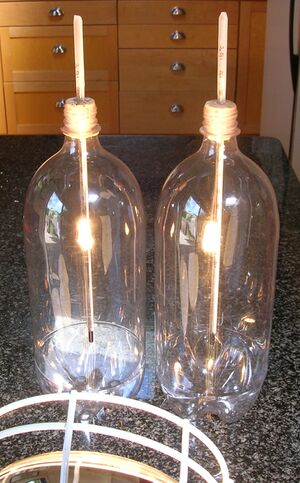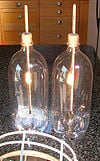
Team Cubic, under the Redwood Coast Energy Authority, set out to design a curriculum to educate 3rd and 4th grade students about the science of climate change. This curriculum will be used by classes in the Humboldt County area.
Background[edit | edit source]
Redwood Coast Energy Authority[edit | edit source]
The Redwood Coast Energy Authority's purpose is to develop and implement sustainable energy initiatives that reduce energy demand, increase energy efficiency, and advance use of clean, efficient and renewable resources available in the region.
Problem statement and criteria[edit | edit source]
Objective[edit | edit source]
Design an appropriate, insightful, memorable, and powerful curriculum that will educate students about the prolonged issues involved with climate change.
Criteria[edit | edit source]
The criteria we have laid out are aspects of the project that we have weighted separately in order to obtain a more objective evaluation of our designs. Below is a list of our chosen criteria in order of importance from most to least.
- Safety
- Informativeness
- Engaging
- Ease of use
- Durability
- Ease of maintenance
- Cost
- Cost
- Practical Timing
Description of final project[edit | edit source]
The final solution is a curriculum that starts with a class discussion, includes three stations that groups will rotate through, and a final class discussion.
Introduction[edit | edit source]
The class is introduced to the topic of climate change with a class discussion. Students are first shown a video from the EPA[1] that is made to start discussion for elementary to junior high students. Students are then broken into groups to complete a rotation of three stations.
Model Atmosphere[edit | edit source]

Students learn about CO2 heat retention compared to normal air heat retention. Two bottles, as shown to the left are heated with a light. One bottle is air and the other contains CO2. The students see that in the course of 15 minutes, the bottle with CO2 will reach a higher temperature than the bottle with just air. Questions on the worksheet pertain to the effects of rising heat, specifically in relation to ice on the planet.
Ice Melt[edit | edit source]
Students learn about the difference of floating ice melting and ice melting from land. The water level of two glasses are the same at the beginning of an experiment. One has floating ice. The other has ice suspended out of the water. The difference in water levels after the ice melts is the focus of this station and is tied into rising sea levels in the next station.
-
Fig 2: The same amount of ice is placed in both glasses
-
Fig 2a: Ice is suspended out of one of the glass representing glaciers. The other glass contains floating ice, representing icebergs.
-
Fig 2b: After the glasses sit under a light, the ice in both glasses melt. It can be observed that the water level in the glass with suspended ice has increased more than the glass with floating ice.
Rising Sea Levels in Humboldt County[edit | edit source]
Students learn about the how rising sea levels might effect Humboldt County. Maps from Firetree[2]are provided to the students in either paper or electronic forms. Each shows a different rise in sea levels. Questions are asked about how Humboldt County would look if sea levels were to rise to these levels.
Conclusion[edit | edit source]
The class concludes the curriculum supplied by the RCEA box with a second discussion. This is to clear up the concepts shown in the stations. This discussion also makes the links between the stations clear (such as melting ice causes rising sea levels).
Photos and descriptions[edit | edit source]
Costs[edit | edit source]
Hours[edit | edit source]

Production of One Box[edit | edit source]
| Material | Quantity | Cost($) | Total($) |
|---|---|---|---|
| Thermometers | 6 | 6.00 | 36.00 |
| Washers | 6 | 0.87 | 5.22 |
| Heat Lamp | 2 | 13.99 | 27.98 |
| Bulb | 2 | 10.99 | 21.98 |
| Bottle | 6 | 1.39 | 8.34 |
| Glasses | 6 | 1.00 | 6.00 |
| Strainers | 3 | 1.00 | 3.00 |
| Ice Trays | 1 | 1.00 | 1.00 |
| Printing Maps | 15 | 2.00 | 30.00 |
| Boxes | 2 | 10.00 | 20.00 |
| Total | $156.52 |
Testing Results[edit | edit source]
Introduction[edit | edit source]
Weather Warnings has not been tested on any subjects. This is due to a failure of the CO2 station. Although all research completed leads to the station being fully functional, team cubic could not replicate reliable results. All variables were changed and tested thoroughly. Many hours were spent trying to produce a functioning prototype, but the results desired could not be produced. Many sources state that the experiment works. Multiple videos have been documented showing the same experiment working. The Weather Warnings prototype is fully functional aside from the CO2 station.
The simplicity of two of the three stations allowed for a quick confidence in reliable and reproducible results.
Ice Melt[edit | edit source]
The ice melt station works without fail every time, clearly showing a greater increase of water level when ice external to the water is melted. With 2 ice cubes from the ice cube tray provided placed into the glasses provided the external ice melt rises .5 inches more than that in the other glass with an experimental deviation of less than .2 inches thus far. This variation here is due to the variable size of each individual ice cube and the lack of perfect symmetry in our glasses.
Rising Sea Levels in Humboldt County[edit | edit source]
The sea level demonstration also has little room for error as the students are looking at reliable pictures. The online source for these maps has not been found to be down or problematic in any way with multiple visits. If this ever does happen there is included in the kit both digital copies and paper hardcopies of the photos of the water levels.
Model Atmosphere[edit | edit source]
Team Cubic has tested many variations of modeling the greenhouse gas effect with no successful results. Model atmospheres will not be included in the final box at this time. More research is needed to find a reliable demonstration that can be recreated in a 3rd or 4th grade classroom.
Discussion and next steps[edit | edit source]
CO2 Model Atmospheres[edit | edit source]
As stated in Prototype Performance, the intended results were not produced by the model atmospheres. If this curriculum is to be implemented in a classroom, more work is needed on this station. It is suggested that new materials be experimented with, and the use of a different gas in place of CO2.
Classroom Test[edit | edit source]
The curriculum has not yet been tested in a classroom. Before the RCEA implements this curriculum, a test in a classroom should be completed.
References[edit | edit source]
- ↑ Environmental Protection Agency http://www.globalchange.gov/resources/educators/toolkit/video http://www.globalchange.gov/resources/educators/toolkit/video
- ↑ Firetree http://flood.firetree.net/


